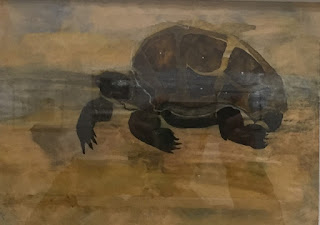Coming home from La Maison Rouge, I had been so impressed by the artist, I kept on muttering his name trying to remember, pronounce it and let it sink into my memory buds. So here we go. Eugène Gabritschevsky (1893 –1979) was a Russian biologist and artist. Born into a comfortable family of scientists from Imperial Russia, his father was a renowned bacteriologist, and worked with Louis Pasteur in France and with Robert Koch in Germany.
Gabritschevsky studied biology at the University of Moscow from 1913, specializing in problems related to heredity. He finished his studies successfully and went into research. In 1924, he was invited to the United States, where he continued his work for two years, and in 1926, settled in Paris, and continued his research at the Pasteur Institute. By the age of thirty-three, he was well known in his field, and world-renowned for his knowledge on the laws of mutation in the lives of insects, which of course, I know absolutely nothing about!
In 1929, his research came to an abrupt end when he was diagnosed with schizophrenia and hospitalized in a mental institution near Munich.
Dubuffet discovered him as he did other mentally ill artists who we have seen together. This man was different though due to a very cultural background. In the ensuing thirty years, Gabritschevsky created an extraordinary body of art: thousands of paintings and drawings. As far as I could see, there were none of his early works included in this exhibition. It will not suprise you that I fell for his animals....practically nothing has a title and many do not include dates.
 |
| 1941 |
 |
| I would say, ooohhh nasty - 1941 |
 |
| I love this |
As his condition worsened, his subjects gradually changed. He started painting ghost-looking silhouettes, large-headed monsters with huge eyes, and then later small beings that look like mutants. However, from my point of view on the same 250 works and drawings around us, there was one « character » that
kept coming back. A fetish creature. It’s body changed and as I studied each painting closely, it often appeared in the background or seemed to be ghostly and flying around in the sky. Look at the paintings closely yourself and you will surely discover much more as I did.
 |
| 1944 |
 |
| 1945 |
 |
| 1949 |
 |
| 1942 |
 |
| 1945 |
 |
| Garden figures - 1953 |
 |
| 1948 |
 |
| 1946/47 |
 |
| 1946/47 | Obviously too, and surely thanks to his background, there are
influences by other artists. Most of all, Munch…as a boy he had been
introduced to many of the Russian artists and later the impressionists.
His father took him to see the Ivan Morozov collections which were
tremendous and very French. |
 |
| 1946/47 |
 |
| 1947 |
The exhibition seemed to be immense. For once we could take photos in La Maison Rouge. Unfortunately the lighting was so bad that shadows were cast on the glass.
 |
| Rübezahl 1951 |
 |
| 1944 |
 |
| Rue Falguière 1944 |
 |
| 1944 |
 |
| 1947/48 |
 |
| 1939 |
 |
| 1950 |
 |
| 1941 |
 |
| 1938 |
 |
| 1952 |
 |
| 1938 |
 |
| 1938/39 | | | | | | |
Too often l saw my own shadow. Once deleted, I felt forlorn, so many had gone.
He died in a Munich hospital on April 5, 1979.
 |
| Eugen Gabritschensky - 1961 |


















































Commentaires